
What does asbestos look like? How can you recognise the hazardous material in your home or workplace? We address some of the most commonly asked questions when it comes to identifying and recognising the risk of asbestos materials.
Asbestos is a naturally occurring mineral that can often be difficult to identify. Heavily used in the manufacturing, industrial, and construction industries in the past, many properties and sites built before the early 2000s will contain asbestos. Approximately one-third of all Australian homes will contain asbestos in one form or another.
The three main types of asbestos mined and used in Australia were Chrysotile (white asbestos), Amosite (brown asbestos), and Crocidolite (blue asbestos). A very fibrous material, asbestos was frequently mixed with many different products to provide fireproofing, insulation, and strength.
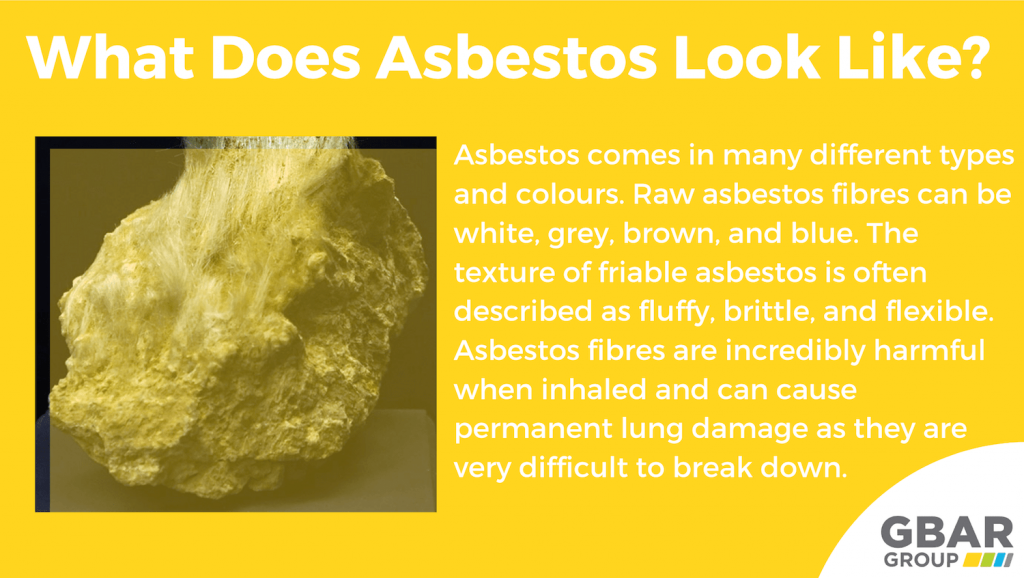
There is a direct link between asbestos exposure and the development of asbestos-related illnesses, including mesothelioma, asbestosis, and lung cancer. It wasn’t until the early 2000s that the use of asbestos was finally halted, due to the overwhelming health risks involved with asbestos exposure. Today, Australia faces a third-wave exposure epidemic, as many asbestos-containing materials remain in place in older buildings.
For safe asbestos removal, a specially trained asbestos removalist needs to survey the material, and have it tested. Once the presence of asbestos is positively confirmed, removalists need to have the materials appropriately abated and disposed of with asbestos state and local regulations.
So, What Does Asbestos Look Like?
Asbestos can be hard to identify as fibres are very small in size, and the nature of the materials means that asbestos was often blended in with other materials. Asbestos was commonly used in houses and properties that were constructed or renovated before 1990. In most commercial forms, raw asbestos will look like attic insulation – a ball of thick fuzz with fairy floss consistency. The individual fibres of asbestos are microscopic and are very harmful when inhaled.
While some materials are marked and dated with asbestos identification, many house-hold products and materials will need testing to confirm the presence of asbestos. Asbestos is a general term that describes six different naturally occurring minerals. These minerals can come in many different colours, textures, forms, and varying degrees of risk.
Materials containing asbestos were typical for the construction of commercial buildings, domestic properties, and industrial sites. Asbestos can be found both inside and on the outside of buildings, raw and mixed in with other materials. Some asbestos materials are easier to identify than others.
What Does Asbestos Look Like Under A Microscope?
Under the microscope, asbestos fibres are long, thin, and have differing shapes. Serpentine group of asbestos is known for its white appearance with long, thin curly ends. Amphibole fibres are rod-shaped, with thin sharp ends, making them more harmful. Amphibole asbestos comes in different colours, depending on the type. Amphibole types include Amosite (brown asbestos), Crocidolite (blue asbestos), Tremolite (whiteish asbestos), and Anthophyllite (grey asbestos).
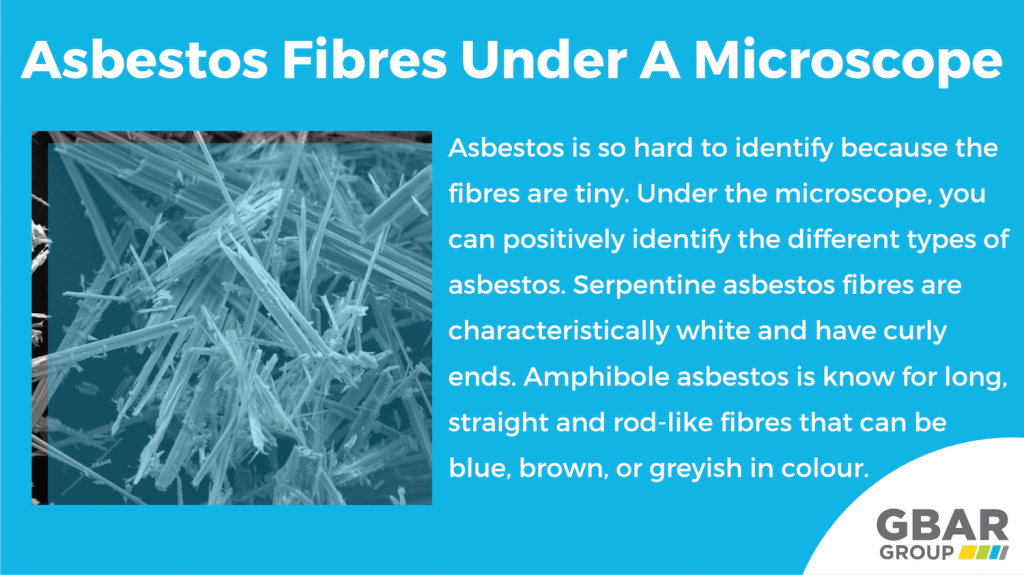
What Does Asbestos Dust Look Like?
Once asbestos fibres are disturbed, they are released into the air and are known as ‘airborne’. Commonly referred to as asbestos dust, these fibres are so tiny they are difficult to detect by the naked eye. In large clouds of asbestos dust, you will be able to see the particles in the air. Asbestos dust is particularly dangerous as it can easily become lodged in the lungs and remain there for life. Asbestos dust can also contaminate clothes, environments, and objects.
What Does Asbestos Sheeting Look Like?
Asbestos was a common addition to cement products, specifically asbestos cement sheeting. Asbestos cement sheeting was a common building material for Australian homes in which the asbestos fibres reinforced thin, rigid cement sheets. An asbestos cement sheeting will typically contain between 5 to 20% asbestos. Adding asbestos makes cement more durable, weatherproof and heat resistant. The most commonly known asbestos sheets were corrugated asbestos sheets, asbestos flat sheets, and asbestos lumber (cement sheathing alternative to timber).
Asbestos cement sheets are white to grey and are very hard. However, when disturbed by power tools or by demolition, these sheets become very brittle and will release friable and harmful asbestos fibres into the air.
What Does Asbestos Insulation Look Like?
Asbestos naturally held many insulation qualities and was heavily used to insulate roofs, pipes, floors and walls. Asbestos insulation was conventional for both thermal and acoustic insulation, and depending on the nature of the insulation, can be found both raw and mixed in with other products.
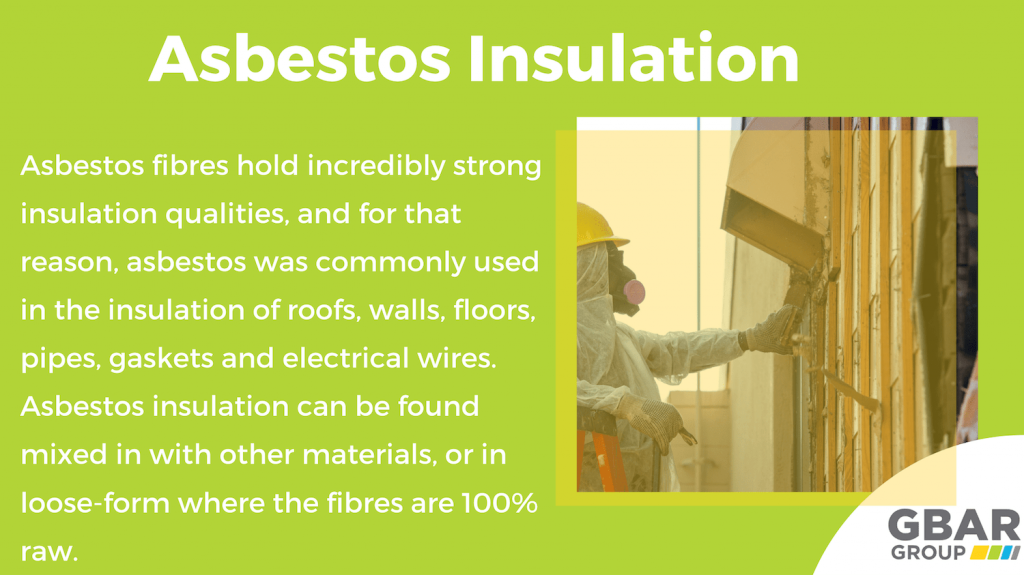
Asbestos was used to insulate hot water pipes for both commercial and domestic properties. The insulation was coated to the outside of the pipes and often sealed with a protective coat of paint. Asbestos insulation on pipes is hazardous when disturbed, and is often described as looking like several layers of paper wrapped around the pipe.
Raw asbestos is most often found in the floor or roof cavities as loose insulation. Asbestos loose-fill insulation is the most harmful form of asbestos and if uncovered, poses a considerable risk to those in the environment. Often blue-grey or white, loose fill is 100% raw asbestos and can be similar to candy floss or pebble-like in texture.
What Does Asbestos Wall Insulation Look Like?
Asbestos insulation board products were especially standard for walls, facades, ceilings, fascia, fireproofing and external cladding. Asbestos insulation board products are very fibrous when disturbed and can be challenging to identify with appropriate testing. Wall asbestos insulation can also be loose-fill asbestos insulation; however, more often, asbestos was commonly used for insulation boards for walls and cladding.
What Does Asbestos Look Like in Popcorn Ceiling?
Popcorn Ceiling was a popular spray-on acoustic or textured ceiling trend for commercial properties. The textured finish was popular during the peak of asbestos usage, and as a result, many popcorn ceilings contain the toxic fibre. Asbestos fibres trapped in popcorn ceilings are not harmful until they are disturbed or damaged. Because the fibres are microscopic, it can be almost impossible to detect asbestos without asbestos accredited lab testing.
What Does Asbestos Paint Look Like?
Asbestos was also commonly used in paints and sealants before being banned in Australia. Old paints in which asbestos was an ingredient can contain as much as 10% asbestos. For houses that were initially painted with asbestos paints, the paints do not pose any risk until they are disrupted by deterioration or demolition. Asbestos paints often do not look any different from regular paints.
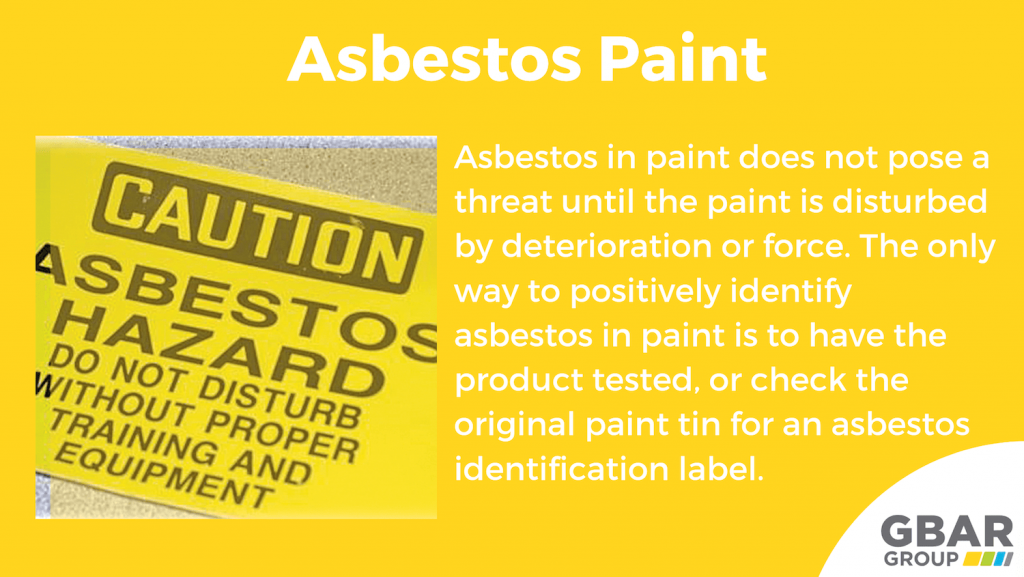
If you have any older paint tins around the house, those that were manufactured with asbestos will have an asbestos label. Be sure to check the ingredients of any older paints before re-opening them or using them.
What Does Asbestos Carpet Underlay Look Like?
Asbestos was frequently used as an adhesive to glue down the carpet underlay, which is a black bitumen-like product. Asbestos carpet underlay can be positively identified with an asbestos test; however, it is not recommended for homeowners to disturb the underlay without appropriate asbestos training.
Asbestos Australia has determined that the risk of asbestos being in carpet underlay in Australian homes was low. However, precautions should still be taken when removing old carpet in the unlikely event asbestos fibres are present. Typically, asbestos carpet underlay products are brown, woven, and have a fibrous texture.
What Does Asbestos Vinyl Flooring Look Like?
Between the 1940s and 1980s, asbestos vinyl flooring was a durable and affordable material that offered many aesthetic options to suit a home’s design. Many Australian homes contain asbestos vinyl flooring, and the material will not pose a threat until the vinyl enclosing is disturbed. While in good condition, the vinyl prevents the fibres from escaping and acts as a bind for the material.
It is not possible to positively identify asbestos in vinyl flooring. However, if upon inspection, the vinyl flooring contains greyish brown, dark grey, brown or black parts, this may be an indication that asbestos fibres are present. It is best to have these tiles appropriately tested with an asbestos specialist.
What Does Asbestos Tile Look Like?
If floor tiles were installed between 1950 and 1985, there’s a high chance they contain asbestos. Asbestos floor tiling often has a type of adhesive on the back of the tile that contains asbestos too. One of the main ingredients used in old asbestos tiles was asphalt, so they were primarily made in dark colours only. Old tiles that are dark in colour may contain asbestos products. If you suspect your floor tiles were made with asbestos, you will need to have samples taken and sent to an accredited lab.
Asbestos Identification
For accurate identification of asbestos materials, an asbestos specialist will need to survey the materials and have them tested with an asbestos accredited laboratory. Asbestos fibres are microscopic and are difficult to identify without these tests. If you suspect your home contains asbestos in some form or another, it is not only illegal to remove it yourself if it is friable, but it will also put your house and your family at risk.
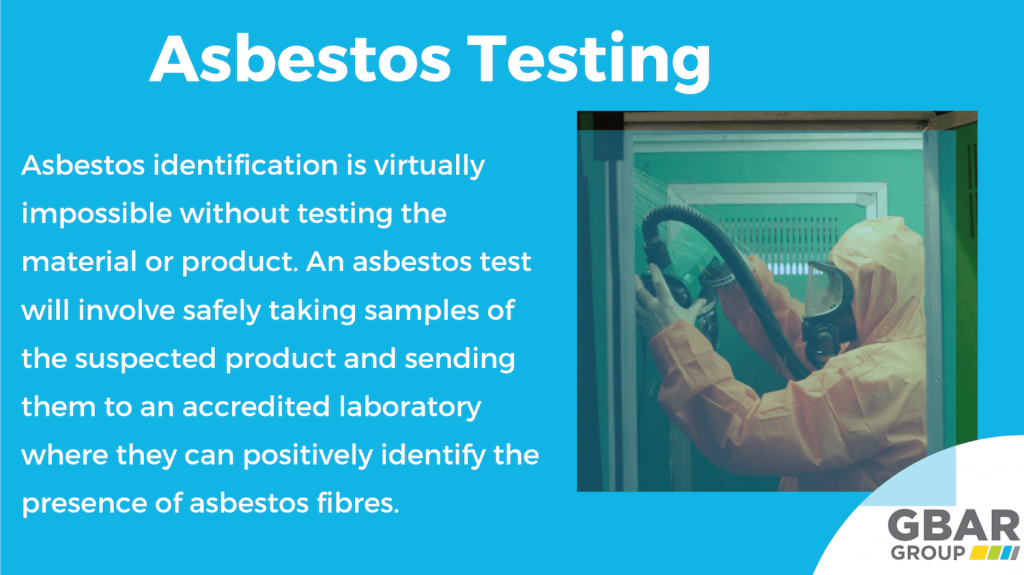
Asbestos removal is dangerous work. Here at GBAR Group, we are committed to spreading awareness of asbestos hazards and safely removing hazardous materials in Sydney, Brisbane, Wollongong, and The Gold Coast.
We assess, remove and remediate all dangerous materials. We specialise in removing both non-friable and friable asbestos for both private and corporate clients. Our team of asbestos specialists are highly qualified and fully certified. If you suspect your property is in danger of asbestos, don’t run the risk – get in touch with our team today.






